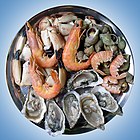Vatapá
 | |
| Place of origin | Brazil |
|---|---|
| Main ingredients | Bread, shrimp, coconut milk, peanuts, palm oil |
| |
Vatapá (Yoruba: vata'pa, [vɐtɐˈpa]) is a Afro-Brazilian dish made from bread, shrimp, coconut milk, finely ground peanuts and palm oil mashed into a creamy paste. It is a typical food of Salvador Bahia and it is also common to the North and Northeast regions of Brazil. In the northeastern state of Bahia it is commonly eaten with acarajé, and as a ritual offering in Candomblé, with acaçá or acarajé. Vatapá is often eaten with white rice in other regions of Brazil. The shrimp can be replaced with ground tuna, chicken or cod among other options.[1]
Contents
1 Etymology
2 Origin
3 See also
4 References
Etymology
"Vatapá" is derived from the term yoruba vata'pa.[2]
Origin
The Vatapá is of African origin, and arrived in Brazil through the Yoruba people with the name of ' ' Ehba-tápa ' '
It is a typical dish of the northeastern cuisine and very traditional in the state of Bahia where they add the oil of palm and also eaten with Caruru. It is also popular in Amazonas, in Amapá and Pará, where the recipe suffers variations such as the absence of peanuts and other common ingredients in the traditional version. The Vatapá has influence of African cuisine brought by the Africans enslaved in slave ships, from 16th century. With the ingredients found in this new land and the need to supplement their food diet, they developed other dishes, which became typical of Brazilian cuisine.
See also
- Matapa
- List of Brazilian dishes
References
^ "Vatapá". whats4eats.com. Retrieved October 7, 2015..mw-parser-output cite.citation{font-style:inherit}.mw-parser-output q{quotes:"""""""'""'"}.mw-parser-output code.cs1-code{color:inherit;background:inherit;border:inherit;padding:inherit}.mw-parser-output .cs1-lock-free a{background:url("//upload.wikimedia.org/wikipedia/commons/thumb/6/65/Lock-green.svg/9px-Lock-green.svg.png")no-repeat;background-position:right .1em center}.mw-parser-output .cs1-lock-limited a,.mw-parser-output .cs1-lock-registration a{background:url("//upload.wikimedia.org/wikipedia/commons/thumb/d/d6/Lock-gray-alt-2.svg/9px-Lock-gray-alt-2.svg.png")no-repeat;background-position:right .1em center}.mw-parser-output .cs1-lock-subscription a{background:url("//upload.wikimedia.org/wikipedia/commons/thumb/a/aa/Lock-red-alt-2.svg/9px-Lock-red-alt-2.svg.png")no-repeat;background-position:right .1em center}.mw-parser-output .cs1-subscription,.mw-parser-output .cs1-registration{color:#555}.mw-parser-output .cs1-subscription span,.mw-parser-output .cs1-registration span{border-bottom:1px dotted;cursor:help}.mw-parser-output .cs1-hidden-error{display:none;font-size:100%}.mw-parser-output .cs1-visible-error{font-size:100%}.mw-parser-output .cs1-subscription,.mw-parser-output .cs1-registration,.mw-parser-output .cs1-format{font-size:95%}.mw-parser-output .cs1-kern-left,.mw-parser-output .cs1-kern-wl-left{padding-left:0.2em}.mw-parser-output .cs1-kern-right,.mw-parser-output .cs1-kern-wl-right{padding-right:0.2em}
^ CUNHA, A. G. Dicionário etimológico Nova Fronteira da língua portuguesa. Rio de Janeiro. Nova Fronteira. p. 812.
This food-related article is a stub. You can help Wikipedia by expanding it. |
This condiment-related article is a stub. You can help Wikipedia by expanding it. |
This Brazilian cuisine-related article is a stub. You can help Wikipedia by expanding it. |



Comments
Post a Comment